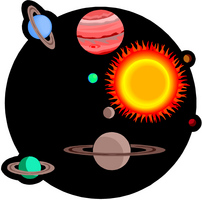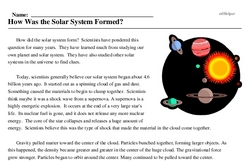How Was the Solar System Formed?
How did the solar system form? Scientists have pondered this question for many years. They have learned much from studying our own planet and solar system. They have also studied other solar systems in the universe to find clues.
Today, scientists generally believe our solar system began about 4.6 billion years ago. It started out as a spinning cloud of gas and dust. Something caused the materials to begin to clump together. Scientists think maybe it was a shock wave from a supernova. A supernova is a highly energetic explosion. It occurs at the end of a very large star's life. Its nuclear fuel is gone, and it does not release any more nuclear energy. The core of the star collapses and releases a huge amount of energy. Scientists believe this was the type of shock that made the material in the cloud come together.
Gravity pulled matter toward the center of the cloud. Particles bunched together, forming larger objects. As this happened, the density became greater and greater in the center of the huge cloud. The gravitational force grew stronger. Particles began to orbit around the center. Many continued to be pulled toward the center. Eventually, 99.9% of the matter in the cloud was pulled to the center. It became very hot and very dense. Nuclear fusion began to take place. The Sun was born. The remaining 0.1% of the matter from the cloud continued to orbit around the Sun. The cloud flattened into a disk because of the constant spinning motion.




